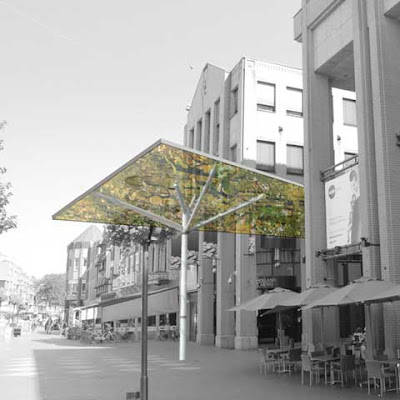Top: The MODERN Rock Garden designed by Tomoko Osonoe, 2009
Bottom: The Planter by Ludwig Ernst Kirchner, 1911STEPHEN ORR
Tomorrow's Garden:
Design and Inspiration for a New Age of Sustainable Gardening
Design and Inspiration for a New Age of Sustainable Gardening
Wednesday, February 24, 2010
Horticultural Lecture Series
Wave Hill
"The heady days of high horticulture, when gardeners would kill for the newest and coolest perennial, are well and truly over..."
from Valerie Easton's article for the Seattle Times,
"In Uncertain Times, Growing Your Food is Fashionable Again, 1/30/2010
"In Uncertain Times, Growing Your Food is Fashionable Again, 1/30/2010
Is horticulture over? On Wednesday night, Stephen Orr answered, YES, kind of. Tomorrow's Gardens: Design and Inspiration for a New Age of Sustainable Gardening (Fall 2010/ Rodale) is the subject of Stephen Orr's upcoming book.
I decided to take it from the top. I googled sustainable. According to Wikipedia, the word sustainable is derived from the Latin sustinere (tenere, to hold; sus, up). In a lengthy explanation of all the possible uses for the word sustainable, Wikipedia has this to say, "For all these reasons sustainability is perceived, at one extreme, as nothing more than a feel-good buzzword with little meaning or substance, but, at the other, as an important but unfocused concept like "liberty" or "justice".
Orr's book comes at an interesting moment in the debate over what kind of gardens we should make. Choosing locations around the country, Orr's book illustrates what gardeners, garden designers and home owners are doing in small spaces to minimize consumption of natural resources. To summarize: more gravel, more permeability, storm water management, rainwater recovery, edible lawns, shared plots, urban farming, median gardening...and even plants, but plants that can adapt to the climate conditions of the local environment.
One of those must-have features for the eco-conscious is the lawn reduced: from wall to wall carpeting to a rug. The lawn (front or back) has become a design object. By reducing its size, this American icon becomes just a shape among other shapes. A rectangle set against squares of box or succulents.
One of those must-have features for the eco-conscious is the lawn reduced: from wall to wall carpeting to a rug. The lawn (front or back) has become a design object. By reducing its size, this American icon becomes just a shape among other shapes. A rectangle set against squares of box or succulents.
For those of us who have been around for a while, we know that gardeners like Piet Oudolf have been making sustainable gardens for years, before this buzzword entered the horticultural lexicon. Orr began his talk on Wednesday by qualifying who the book was for. He said it was aimed at people in the middle of the country, where the jargon wasn't bandied about so much and actual sustainable gardening practices hadn't become chic yet.
Orr ended his talk with his own property in upstate New York. Small house, shaded piece of property, a few ferns, surrounded by woods: a piece of land hard to garden on. To paraphrase Orr "I am training my eye to notice the ordinary... mushrooms, a native orchid, small surprises."
I am in training to. I made a resolution this year, not to buy anymore books, especially gardening books. I don't have any more shelf space, I haven't read a lot of the books I bought last year and I keep going back to the gardening books I have been dog-earing for years. But I might have to change my mind and pick up a copy of Stephen Orr's upcoming book.
*Not to confuse the subject. Stephen Orr's talk Wednesday night, was the subject of his book. The book has not been published yet. The photos above are not from his book. I put the two pictures together to illustrate two different ideas of planters that have involved over time.

































 snap du jour (photo blog)
snap du jour (photo blog)




